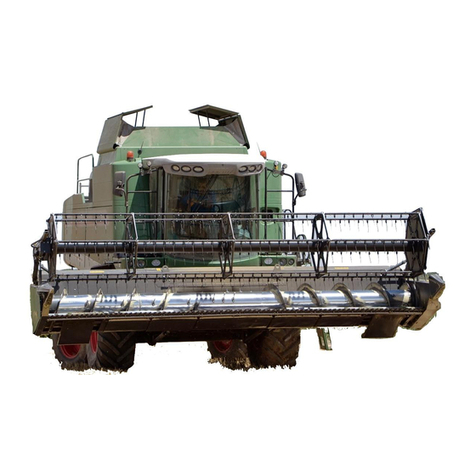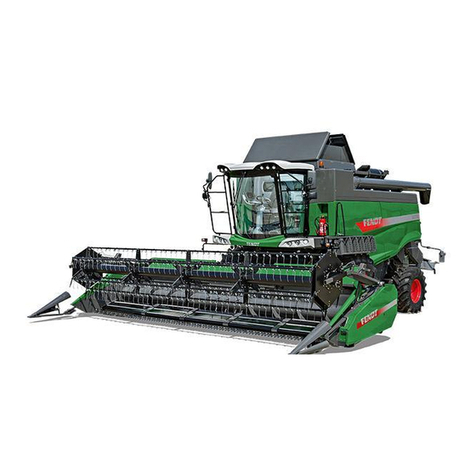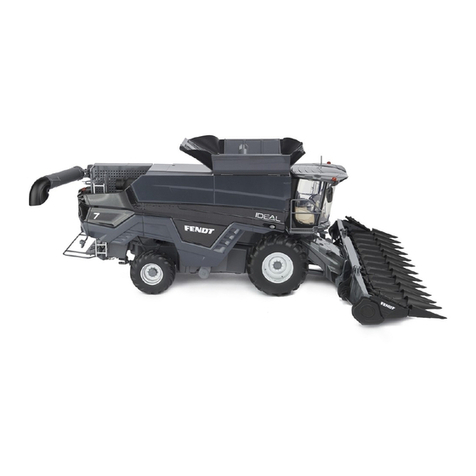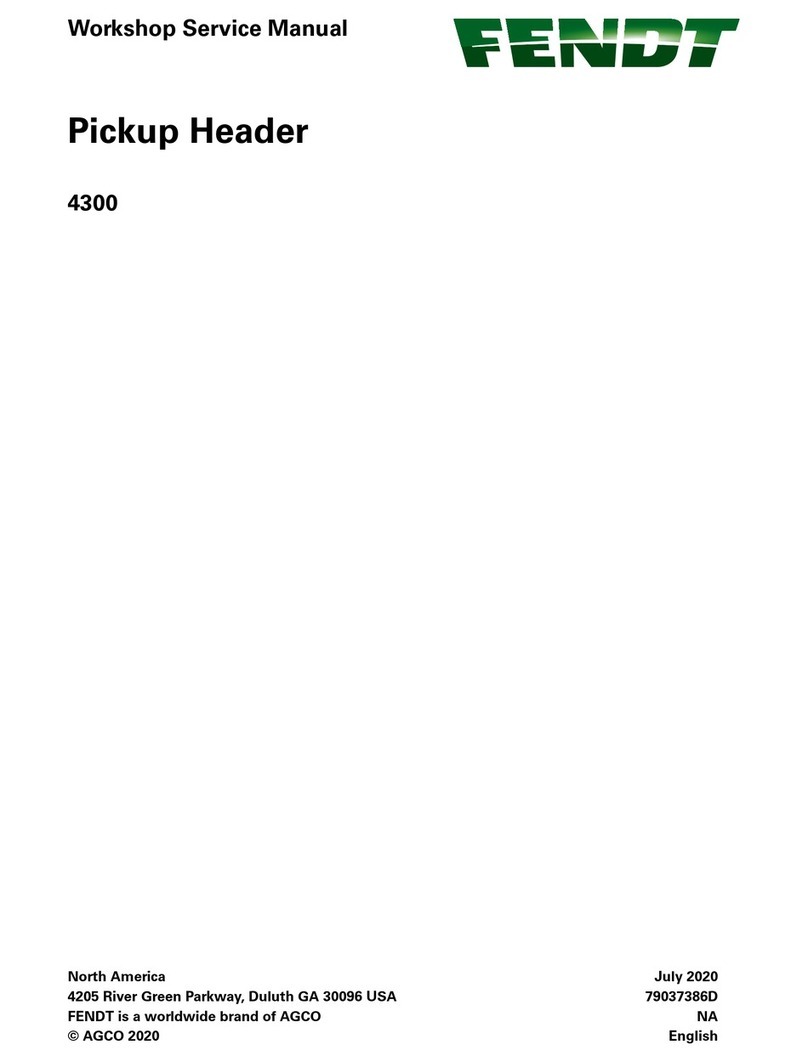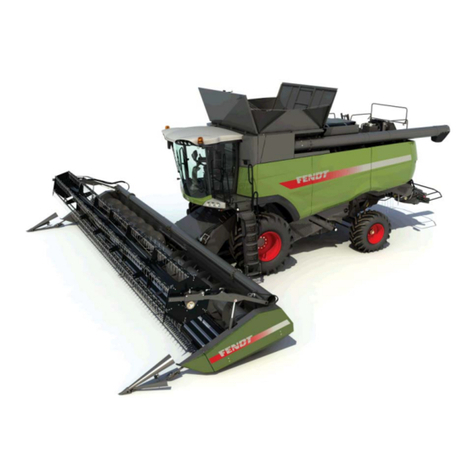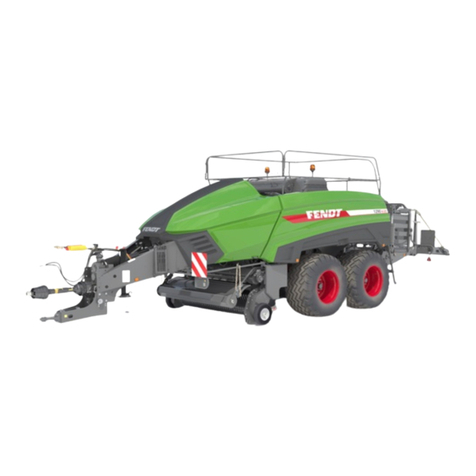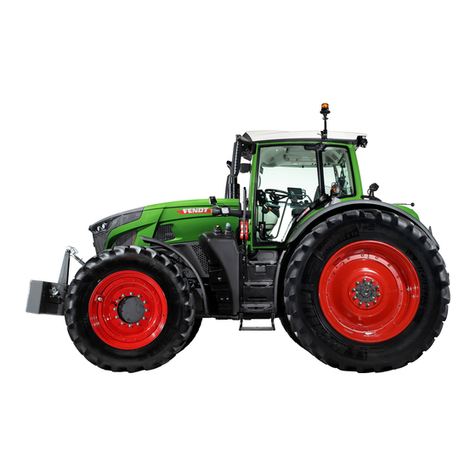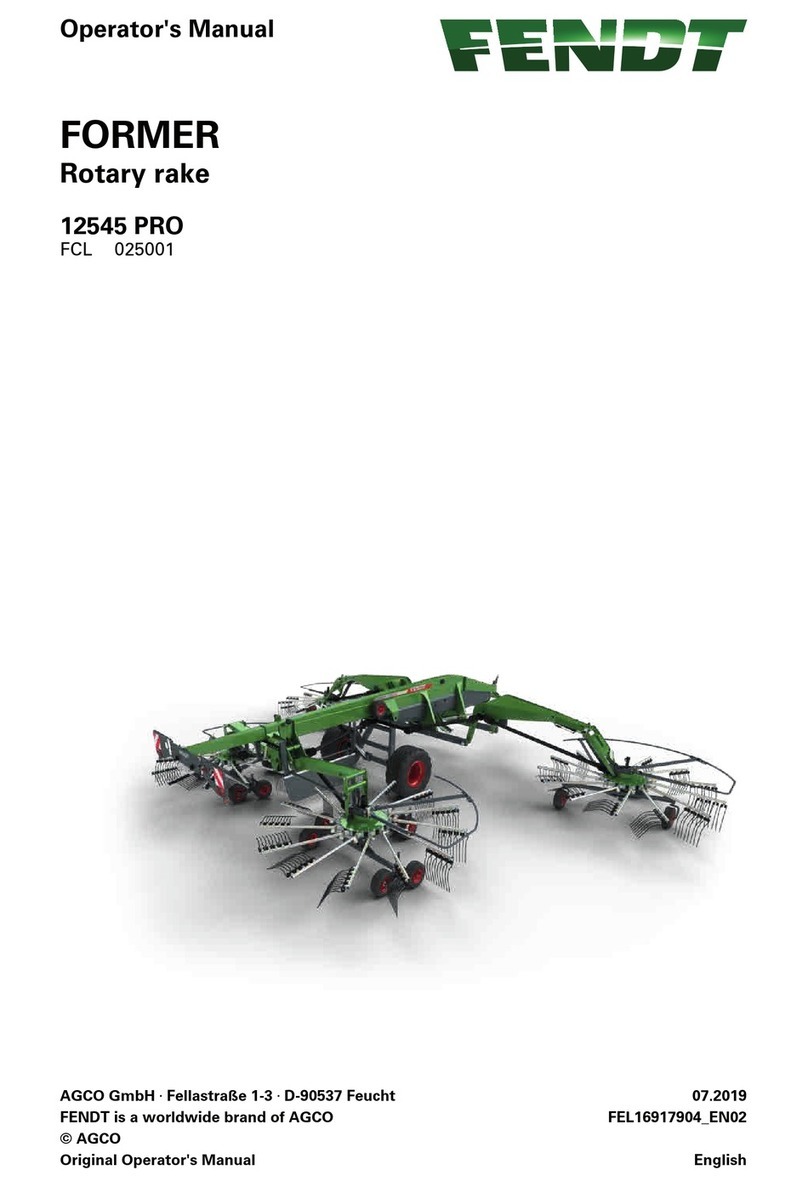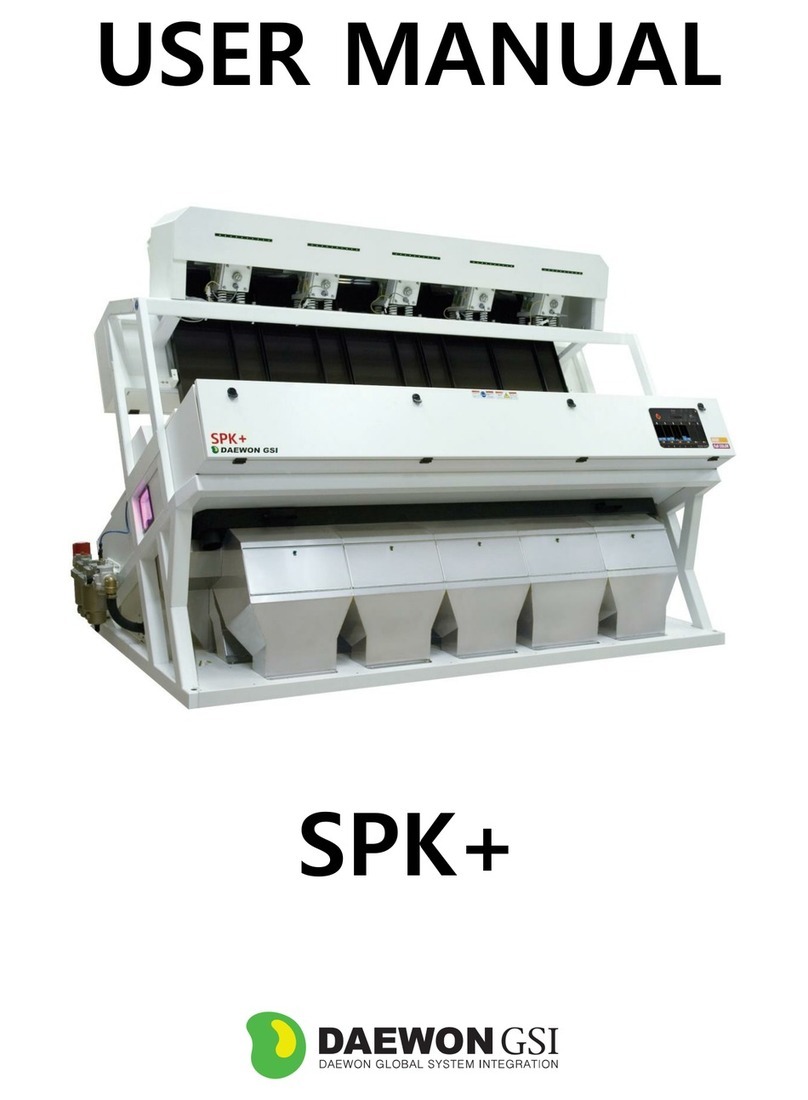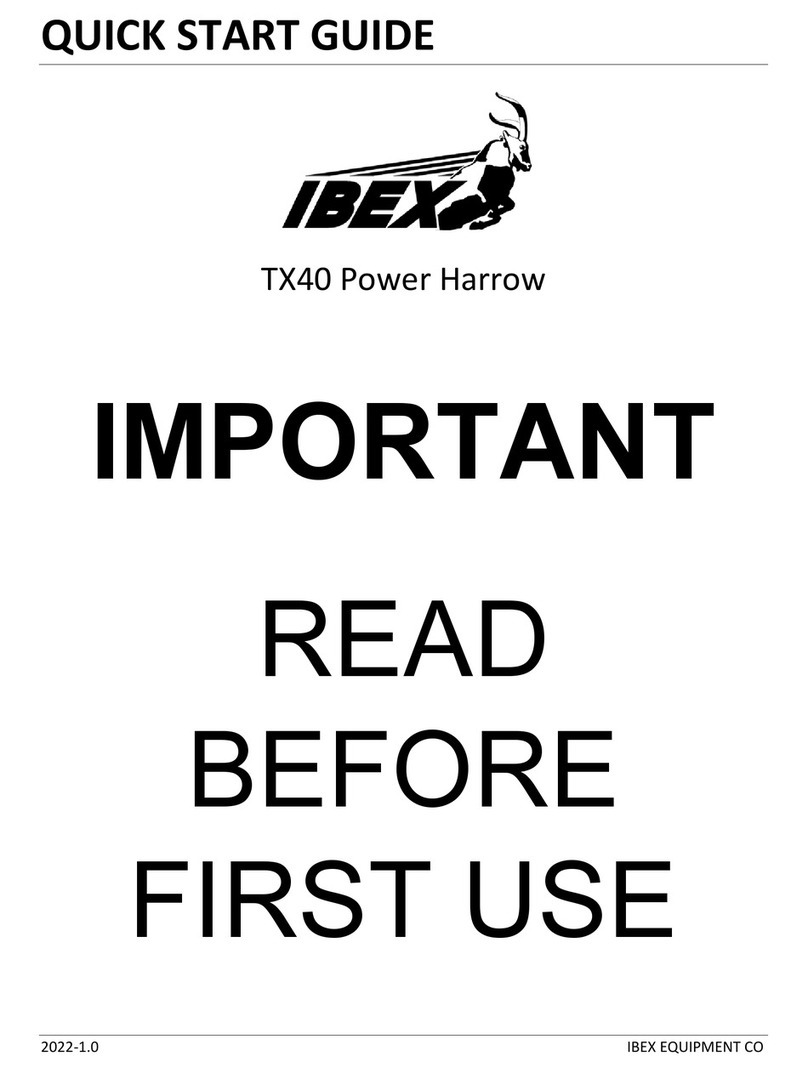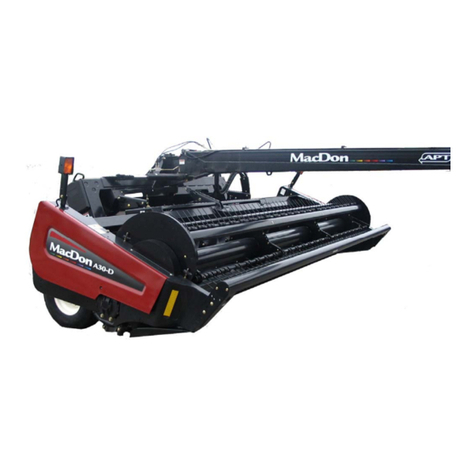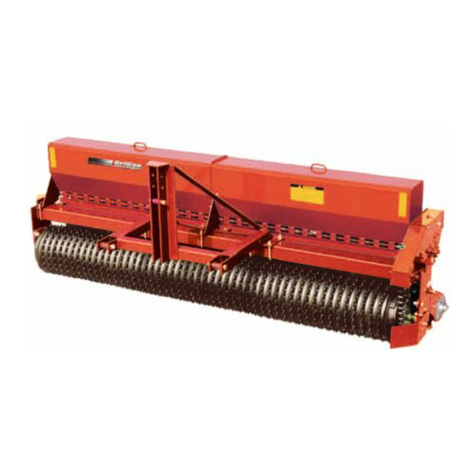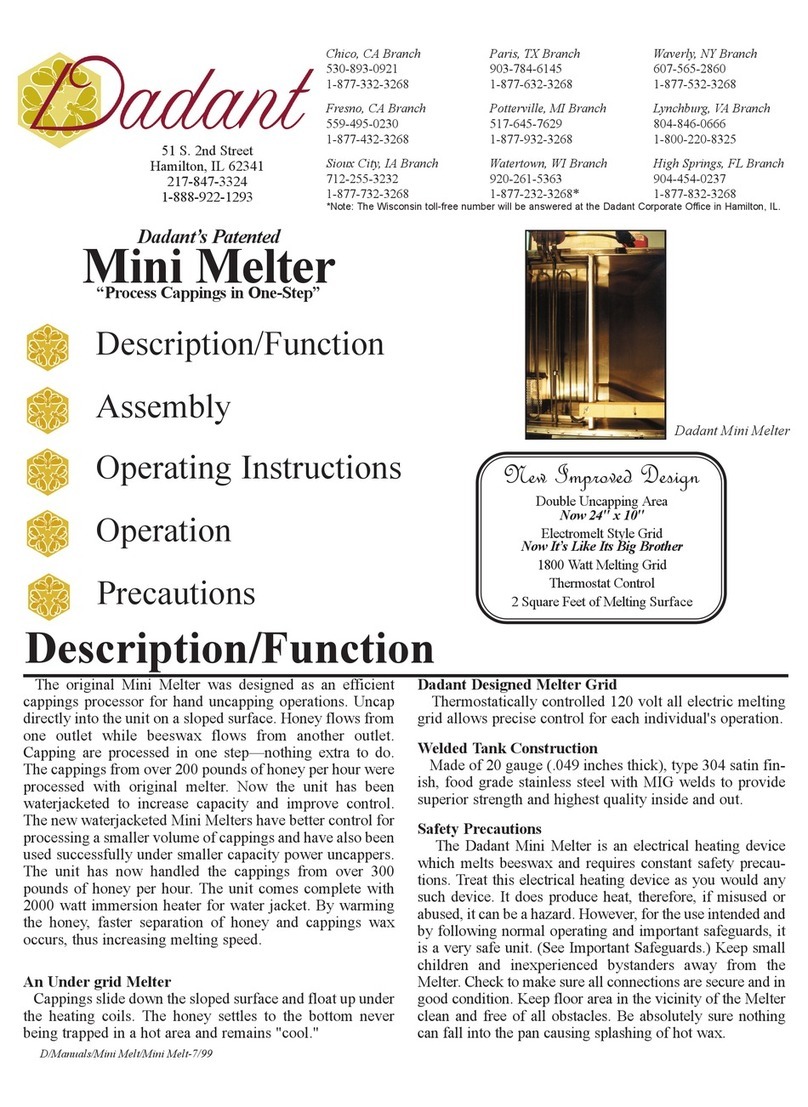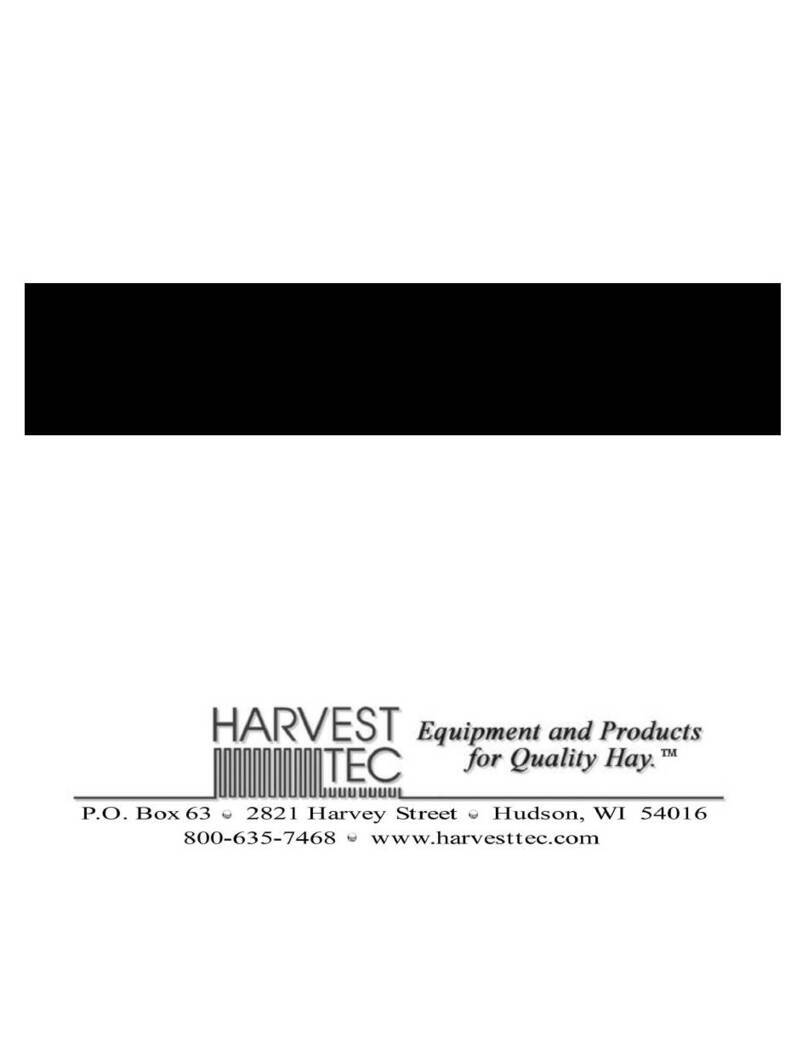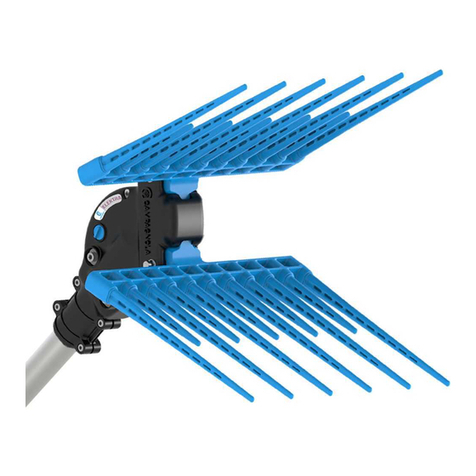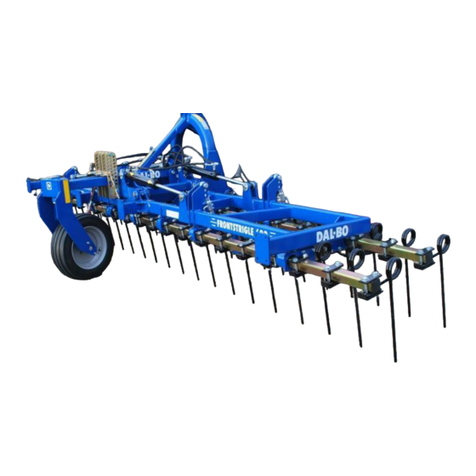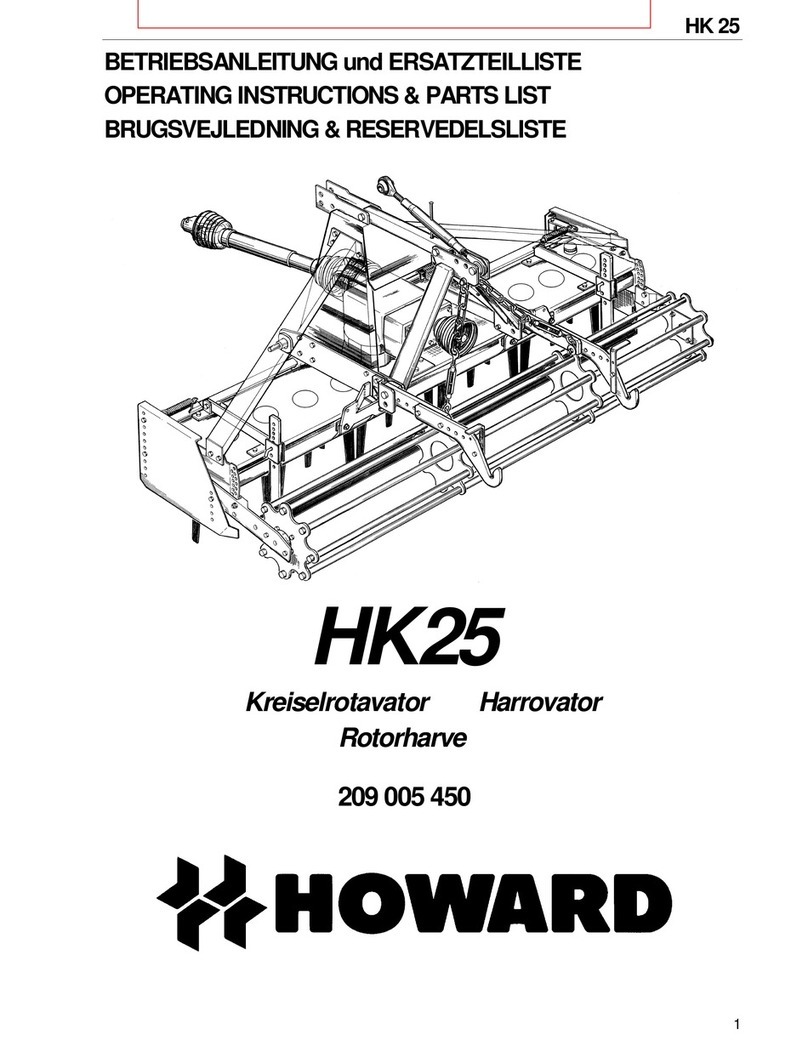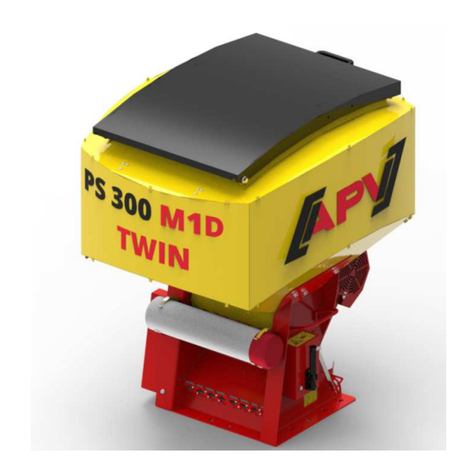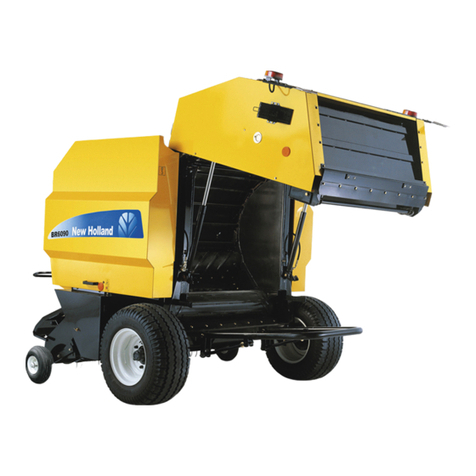FENDT BALER Series User manual

SERIES BALER
OPERATOR MANUAL
FENDT™
870N / 870S / 990N / 990S / 1270N / 1270S /
1290N / 1290S / 12130N / 12130S
Large Square Baler

TO OUR CUSTOMER:
Congratulations on your selection of a FENDT
Product. We believe you
have exercised excellent judgment in the purchase of your FENDT
machine. We are most appreciative of your patronage.
Your Dealer has performed the pre-delivery service on your new
machine.
He will discuss with you the operating and maintenance instructions given
in this manual, and instruct you in the proper and varied applications of this
machine. Call on him at any time when you have a question or need
equipment related to the use of your machine.
We recommend that you carefully read this entire manual before
operating the unit. Also, time spent in becoming fully acquainted with its
performance features, adjustments, and maintenance schedules will be
repaid in a long and satisfactory life of the product.
This equipment is covered by a written warranty which will be
provided to you by your FENDT
Dealer at time of purchase.
AGCO
®
reserves the right to make changes or add improvements to its products at any time without incurring any
obligation to make such changes to products manufactured previously. AGCO
®
, or its dealers, accept no responsibility
for variations which may be evident in the actual specifications of its products and the statements and descriptions
contained in this publication.
FENDTis a worldwide brand of AGCO Corporation, Duluth, Georgia
CALIFORNIA
Proposition 65 Warning
WARNING: Diesel engine exhaust and some of its constituents are
known to the State of California to cause cancer, birth defects, and
other reproductive harm.
WARNING: Battery posts, terminals and related accessories contain
lead and lead compounds, chemicals known to the State of California
to cause cancer, birth defects, and other reproductive harm. Wash
hands after handling.
Find manuals at https://best-manuals.comFind manuals at https://best-manuals.com

700735021 E Rev. A-i
CONTENTS
Original Instructions
FENDT™
870N / 870S / 990N / 990S / 1270N / 1270S / 1290N / 1290S /
12130N / 12130S
700735021 E Rev.
CONTENTS
SAFETY ............................................................................................................................................................. A-1
GENERAL INFORMATION ................................................................................................................................ B-1
PREPARATION ................................................................................................................................................. C-1
ELECTRONICS ................................................................................................................................................. D-1
OPERATION ...................................................................................................................................................... E-1
ADJUSTMENTS ................................................................................................................................................. F-1
LUBRICATION AND MAINTENANCE ............................................................................................................... G-1
TROUBLESHOOTING ....................................................................................................................................... H-1
SPECIFICATIONS .............................................................................................................................................. J-1
ACCESSORIES AND OPTIONS ....................................................................................................................... K-1
ASSEMBLY ......................................................................................................................................................... L-1
INDEX ................................................................................................................................................................ M-1
Find manuals at https://best-manuals.comFind manuals at https://best-manuals.com

700735021 E Rev. A-1
SAFETY
SAFETY
Contents
Safety Alert Symbol ........................................................................................................................................ A-3
Safety Messages ............................................................................................................................................ A-3
Informational Messages .................................................................................................................................. A-3
Safety Signs .................................................................................................................................................... A-4
A Word To The Operator ................................................................................................................................ A-4
Operator Manual ............................................................................................................................................. A-5
Prepare For Operation .................................................................................................................................... A-5
Operation ........................................................................................................................................................ A-6
General Information .................................................................................................................................. A-6
Personal Protection Equipment ................................................................................................................ A-7
Seat Instructions ....................................................................................................................................... A-7
Shields and Guards .................................................................................................................................. A-8
Exhaust Warning ...................................................................................................................................... A-8
Flying Debris ............................................................................................................................................ A-9
Handrails .................................................................................................................................................. A-9
Agricultural Chemicals .............................................................................................................................. A-9
Travel On Public Roads ................................................................................................................................ A-10
Maintenance ................................................................................................................................................. A-11
General Information ................................................................................................................................ A-11
Fire Prevention and First Aid .................................................................................................................. A-13
Checking for High Pressure Leaks ......................................................................................................... A-14
Tire Safety .............................................................................................................................................. A-14
Text Safety Signs and Information Signs ...................................................................................................... A-15
Left-hand Side of the Baler ..................................................................................................................... A-15
Under the Left-hand Shield .................................................................................................................... A-23
Rear of the Baler .................................................................................................................................... A-24
Right-hand Side of the Baler .................................................................................................................. A-27
No-Text Safety Signs and Information Signs ................................................................................................ A-32
Safety Signs, Hazard and Avoidance ..................................................................................................... A-32
Left-hand Side of the Baler ..................................................................................................................... A-33
Under the Left-hand Shield .................................................................................................................... A-41
Left-hand Rear of the Baler .................................................................................................................... A-43
Right-hand Side of the Baler .................................................................................................................. A-46
Find manuals at https://best-manuals.comFind manuals at https://best-manuals.com

700735021 E Rev. A-3
SAFETY
SAFETY ALERT SYMBOL
FIG. 1: The safety alert symbol means ATTENTION!
BECOME ALERT! YOUR SAFETY IS INVOLVED!
Look for the safety alert symbol both in this manual and
on the safety signs on this baler. The safety alert symbol
will direct you to information that involves your safety and
the safety of others.
SAFETY MESSAGES
FIG. 2: The words DANGER, WARNING or CAUTION
are used with the safety alert symbol. Learn to recognize
these safety alerts and follow the recommended
precautions and safety practices.
mDANGER: Indicates an imminently
hazardous situation that, if not avoided, will
result in DEATH OR VERY SERIOUS
INJURY.
mWARNING: Indicates a potentially
hazardous situation that, if not avoided,
could result in DEATH OR SERIOUS
INJURY.
mCAUTION: Indicates a potentially
hazardous situation that, if not avoided,
may result in MINOR INJURY.
INFORMATIONAL MESSAGES
The words IMPORTANT and NOTE are not related to
personal safety, but are used to give additional
information and tips for operating or servicing this
equipment.
IMPORTANT: Identifies special instructions or
procedures which, if not strictly observed, could
result in damage to or destruction of the
machine, process, or its surroundings.
NOTE: Identifies points of particular interest for more
efficient and convenient repair or operation.
FIG. 1
Saf
FIG. 2
WC1957
Find manuals at https://best-manuals.comFind manuals at https://best-manuals.com

SAFETY
A-4 700735021 E Rev.
SAFETY SIGNS
mWARNING: DO NOT remove or obscure
Danger, Warning or Caution signs. Replace
any Danger, Warning or Caution signs that
are not readable or are missing.
Replacement signs are available from your
dealer in the event of loss or damage. The
actual location of the safety signs is
illustrated at the end of this section.
Keep signs clean by wiping off regularly. use a cleaning
solution if necessary.
If a used machine has been purchased, make sure all
safety signs are in the correct location and can be read.
See Safety Sign Location in this section for illustrations.
Replace any safety signs that can not be read or are
missing. Clean the machine surface thoroughly with a
cleaning solution before replacing signs. Replacement
safety signs are available from your dealer.
A WORD TO THE OPERATOR
FIG. 3: It is YOUR responsibility to read and understand
the safety section in this manual and the manual for all
attachments before operating this machine. Remember
YOU are the key to safety. Good safety practices not only
protect you, but also the people around you.
Study the features in this manual and make them a
working part of your safety program. Keep in mind that
this safety section is written only for this type of machine.
Practice all other usual and customary safe working
precautions, and above all REMEMBER - SAFETY IS
YOUR RESPONSIBILITY. YOU CAN PREVENT
SERIOUS INJURY OR DEATH.
This safety section is intended to point out some of the
basic safety situations that may be encountered during
the normal operation and maintenance of your machine.
This section also suggests possible ways of dealing with
these situations. This section is NOT a replacement for
other safety practices featured in other sections of this
manual.
Personal injury or death may result if these precautions
are not followed.
Learn how to operate the machine and how to use the
controls properly.
Do not let anyone operate the machine without instruction
and training.
For your personal safety and the personal safety of
others, follow all safety precautions and instructions found
in the manuals and on safety signs affixed to the machine
and all attachments. Use only approved attachments and
equipment.
FIG. 3
S-1123
Find manuals at https://best-manuals.comFind manuals at https://best-manuals.com

700735021 E Rev. A-5
SAFETY
Make sure your machine has the correct equipment
needed by the local regulations.
mWARNING: An operator should not use
alcohol or drugs which can affect their
alertness or coordination. An operator on
prescription or ‘over the counter’ drugs
needs medical advice on whether or not
they can properly operate machines.
mCAUTION: If any attachments used on this
equipment have a separate Operator
Manual, see that manual for other important
safety information.
OPERATOR MANUAL
This manual covers general safety practices for this
machine. The Operator Manual must always be kept with
the machine.
Right-hand and left-hand, as used in this manual, are
determined by facing the direction the machine will travel
when in use.
The photos, illustrations, and data used in this manual
were current at the time of printing, but due to possible
inline production changes, your machine can vary slightly
in detail. The manufacturer reserves the right to redesign
and change the machine as necessary without
notification.
mWARNING: In some of the illustrations or
photos used in this manual, shields or
guards may have been removed for clarity.
Never operate the machine with any shields
or guards removed. If the removal of
shields or guards is necessary to make a
repair, they MUST be replaced before
operation.
FIG. 4: The Operator Manual is stored in the holder (1)
on the machine. After using the Operator Manual, return
the manual to the storage location.
PREPARE FOR OPERATION
Read and understand all operating instructions and
precautions in this manual before operating or servicing
the machine.
FIG. 4
N115922
1
Find manuals at https://best-manuals.comFind manuals at https://best-manuals.com

SAFETY
A-6 700735021 E Rev.
Make sure you know and understand the positions and
operations of all controls. Make certain all controls are in
neutral and the parking brake is applied before starting
the machine.
Make certain all people are well away from your area of
work before starting and operating the machine. Check
and learn all controls in an area clear of people and
obstacles before starting your work. Be aware of the
machine size and have enough space available to allow
for operation. Never operate the machine at high speeds
in crowded places.
Emphasize the importance of using correct procedures
when working around and operating the machine. Do not
let unqualified persons to operate the machine. Keep
others, especially children, away from your area of work.
Do not permit others to ride on the machine.
Make sure the machine is in the proper operating
condition as stated in the Operator Manual. Make sure
the machine has the correct equipment required by local
regulations.
All equipment has a limit. Make sure you understand the
speed, brakes, steering, stability, and load characteristics
of this machine and the tractor before you start.
OPERATION
General Information
FIG. 5: When parking, park the machine and the tractor
on a solid level surface. put all controls in neutral and
apply the tractor parking brake. Stop the tractor engine
and take the key with you.
Make sure the tractor and implement are in the proper
operating condition according to the operator manuals.
Make sure the tractor brakes and the machine brakes are
adjusted correctly.
The tractor must have enough weight and braking
capacity, especially when operating on roads and terrain
that is not even. Use a tractor of recommended size and
weight to tow the machine. See the Specifications section
in this manual for the minimum tractor size and weight.
Tractor must be equipped with rollover protective structure
(ROPS) and a seat belt. use seat belt during operation.
Do not dismount from moving machinery.
Always operate the machine with the control console
turned on.
Never start the tractor with the PTO engaged or control
console turned on.
Where possible avoid operating the baler near ditches,
embankments and holes. Reduce speed when turning,
crossing slopes, and on rough, slippery, or muddy
surfaces.
Stay off slopes too steep for operation.
Be aware of the size of the equipment and have enough
space available to allow for operation.
FIG. 5
D-7084
Find manuals at https://best-manuals.comFind manuals at https://best-manuals.com

700735021 E Rev. A-7
SAFETY
Make sure all persons are clear of the rear of the bale
chute when raising and lowering the chute, ejecting or
dumping a bale.
Do not stand between the tractor and the implement to
install the hitch pin when the tractor engine is running.
FIG. 6: Avoid contact with electrical power lines. Contact
with electrical power lines can cause electrical shock,
resulting in very serious injury or death.
Personal Protection Equipment
FIG. 7: Wear all personal protective equipment (PPE)
and protective clothing issued to you or called for by job
conditions and country/local regulations. PPE includes,
but is not limited to, equipment to protect eyes, lungs,
ears, head, hands and feet when operating, servicing or
repairing equipment.
Always keep hands, feet, hair, and clothing away from
moving parts. Do not wear loose clothing, jewelry,
watches, or other items that could entangle in moving
parts.
Seat Instructions
FIG. 8: Securely fasten the seat belt before operating the
machine. Always remain seated and have the seat belt
fastened while operating the machine. Replace the seat
belts when they become worn or broken.
Never wear a seat belt loosely or with slack in the belt
system. Never wear the seat belt in a twisted condition or
pinched between the seat structural members.
When using the instructional seat, if equipped, securely
fasten the seat belt. The instructional seat is to be used
only to train new operators or diagnose a problem. The
instructional seat is only intended for short periods of use.
Extra riders, especially children, are not permitted on the
machine.
When the instructional seat is used the machine must be
driven at a slower speed and on level ground. Avoid quick
starts, stops, and sharp turns. Avoid driving on highways
or public roads.
FIG. 6
D-15022
FIG. 7
S-1127A
FIG. 8
WC1953A

SAFETY
A-8 700735021 E Rev.
Shields and Guards
FIG. 9: All shields and guards must be in the correct
operating position and in good condition.
FIG. 10: Do not operate the machine with the drive shaft
shields open or removed. Entanglement in rotating drive
shafts can cause serious injury or death. Stay clear of
rotating components.
Make sure rotating guards turn freely.
Exhaust Warning
FIG. 11: Never operate the engine (if equipped) in a
closed building unless the exhaust is vented outside.
FIG. 9
71389544C
FIG. 10
WC1941
FIG. 11
WC1949

700735021 E Rev. A-9
SAFETY
Flying Debris
FIG. 12: Never stand near the machine during operation.
Debris can be thrown from the machine during operation
possibly resulting in injury.
Handrails
FIG. 13: Face the ladder and use the handrails when
getting on or off the machine.
Agricultural Chemicals
Agricultural chemicals can be very hazardous. Improper
use of fertilizer, fungicides, herbicides, insecticides and
pesticides can injure people, plants, animals, soil and
other people’s property.
Always read and follow all manufacturers’ instructions
before opening any chemical container.
Even if you think you know the instructions, read and
follow instructions each time you use a chemical.
Use the same precautions when adjusting, servicing,
cleaning or storing the machine as are used when
installing chemicals into the hoppers or tanks.
Inform anyone who comes in contact with chemicals of
the potential hazards involved and the safety precautions
required.
Stand upwind and away from smoke from a chemical fire.
Store or dispose of all unused chemicals only in a manner
as specified by the chemical manufacturer.
FIG. 12
D-8278
FIG. 13
WC1940

SAFETY
A-10 700735021 E Rev.
TRAVEL ON PUBLIC ROADS
FIG. 14: Make sure you understand the speed, brakes,
steering, stability, and load characteristics of this machine
and the tractor before you travel on public roads.
Use good judgement when traveling on public roads.
Maintain complete control of the machine at all times.
Never coast down hills.
The maximum speed of farm equipment is governed by
local regulations. Adjust travel speed to maintain control
at all times. See Specifications for the maximum speed for
this machine.
Make sure the tractor is in the proper operating condition
according to the tractor operator manual. Make sure the
tractor brakes and the machine brakes, if equipped, are
adjusted correctly. The tractor must have enough weight
and braking capacity, especially when operating on roads
and terrain that is not even. To achieve proper braking
capacity, use tractor of recommended size and weight to
tow the machine. See Specifications for the minimum
tractor weight.
Familiarize yourself with and obey all road regulations that
apply to your machine. Consult your local law
enforcement agency for local regulations regarding
movement of farm equipment on public roads. Use
headlights, flashing warning lights, taillights and turn
signals, day and night, unless prohibited by local law.
Make sure all the flashers are operating prior to driving on
the road. Make sure reflectors are correctly installed, in
good condition, and wiped clean. Make sure the Slow
Moving Vehicle (SMV) emblem, if equipped, is clean,
visible, and correctly mounted on the rear of the machine.
Do not operate the baler on the road with a bale in the
chamber.
Be aware of other traffic on the road. Keep well over to
your own side of the road and pull over, whenever
possible, to let faster traffic pass.
Be aware of the overall width, length, height, and weight
of the equipment. Be careful when transporting the
machine on narrow roads and across narrow bridges.
Always install the safety transport chain between the
implement and the tractor drawbar.
• Use a safety transport chain with a strength rating
equal to or more than the gross weight of the towed
machines.
• Connect the safety transport chain to the tractor
drawbar and use a retainer on the hitch pin.
• Supply only enough slack in the safety transport
chain to permit turning.
• Do not use the safety transport chain as a tow chain
for towing.
FIG. 14
S-1025

700735021 E Rev. A-11
SAFETY
FIG. 15: Watch for overhead wires and other
obstructions. Avoid contact with electrical power lines.
Contact with electrical power lines can cause electrical
shock, resulting in very serious injury or death.
MAINTENANCE
General Information
FIG. 16: Before doing any unplugging, lubricating,
servicing, cleaning, or adjusting:
• Park the machine on a solid level surface.
• Disengage the tractor PTO.
• Put the tractor transmission in PARK and apply the
tractor parking brake.
• Turn off the control console.
• Stop the tractor engine and take the key with you.
• Apply the baler flywheel brake.
• Apply the baler parking brake (if equipped).
• Look and Listen! Make sure all moving parts have
stopped.
• Put blocks in front of and behind the wheels of the
machine and the tractor before working on or under
the machine.
Do not leave the tractor or implement unattended with the
engine running.
Do not pull crop, twine, or any other object from the
machine while the tractor engine is running. Moving parts
can pull you in faster than you can move away.
Do not attempt to service or adjust the machine until all
moving parts have stopped.
Check all nuts and bolts periodically for tightness,
especially wheel mounting hardware.
After unplugging, lubricating, servicing, cleaning, or
adjusting the machine make sure all tools and equipment
have been removed.
Make sure electrical connectors are clean and free of dirt
or grease before connecting.
Check for loose, broken, missing, or damaged parts.
Make sure the baler is in good repair. Make sure all
guards and shields are in position.
FIG. 15
D-15022
FIG. 16
D-8518

SAFETY
A-12 700735021 E Rev.
Be aware of the size of parts when doing service work.
Never stand under or near a part being moved with lifting
equipment.
FIG. 17: Never service, check or adjust the drive chains
or belts while the tractor engine is running.
FIG. 18: Do not operate the machine with the drive shaft
shields open or removed. Entanglement in rotating drive
shafts can cause serious injury or death.
Stay clear of rotating components.
Never start the tractor with the PTO engaged.
Make sure rotating guards turn freely.
A loose yoke can slip off the tractor PTO shaft and result
in injury to persons or damage to the machine.
When installing a quick disconnect yoke, the spring
activated locking pins must slide freely and be seated in
the groove on the PTO shaft.
Pull on the implement driveline to make sure the quick
disconnect yoke cannot be pulled off the PTO shaft.
FIG. 19: Disengage the tractor PTO. Turn off the tractor
engine. Remove the key. Take the key with you. Apply the
flywheel brake. Engage the knotter/needle lockout before
threading the needles, threading the knotters or adjusting
the twine tensioners.
Serious injury can result from threading the needles,
threading the knotters or adjusting the twine tensioners
with a baler running.
The needle frame and the knotters can move without
putting hay in the baler.
When working with or around the needles or knotters
always engage the knotter/needle lockout.
Do not try to remove twine from the bale chamber or
knotter while the baler is running.
FIG. 17
wc1943
FIG. 18
WC1941
FIG. 19
700720126a

700735021 E Rev. A-13
SAFETY
Fire Prevention and First Aid
FIG. 20: Be prepared for emergencies.
Keep a first aid kit handy for treatment of minor cuts and
scratches.
Always carry one or more fire extinguishers of the correct
type. Check fire extinguishers regularly as instructed by
the manufacturer. Make sure fire extinguishers are
properly charged and in operating condition.
Due to the nature of the crops this machine will operate in,
the risk of fire is of concern. Use a water type fire
extinguisher or other water source for a fire in crop.
For fires involving anything other than crop, such as oil or
electrical components, use a dry chemical fire
extinguisher with an ABC rating.
Mount fire extinguishers within easy reach of where fires
can occur.
Frequently remove accumulated crop material from the
machine and check for overheated components. Check
the machine daily for any noises that are not normal.
Such noises could indicate a failed component that can
cause excess heat.
If any flame cutting, welding, or arc welding is to be done
on the machine or attachments, make sure to clear any
crop material or debris from around the area. Make sure
the area below the work area is clear of any flammable
material as falling molten metal or sparks can ignite the
material.
At the end of each season, or if the baler will sit for more
than 48 hours after baling high moisture crops, remove all
crop from the bale chamber using the bale ejector, if
equipped, or fill the bale chamber with dry crop.
FIG. 21: If fire occurs stand upwind and away from
smoke from the fire.
FIG. 20
S-1131
FIG. 21
wc1946

SAFETY
A-14 700735021 E Rev.
Checking for High Pressure Leaks
FIG. 22: Fluid leaking from the hydraulic system or the
fuel injection system under high pressure can be very
hard to see. The fluid can go into the skin causing serious
injury.
Fluid injected into the skin must be surgically removed
within a few hours. If not removed immediately, serious
infection or reaction can develop. Go immediately to a
doctor who knows about this type of injury.
FIG. 23: Use a piece of cardboard or wood to look for
possible leaks. Never use your bare hands. Wear leather
gloves for hand protection and safety goggles for eye
protection.
Relieve all pressure before loosening any hydraulic lines.
Relieve the pressure by lowering raised equipment,
shutting off accumulator valve, if equipped, and shutting
off the engine. Tighten all connections securely before
applying pressure.
Tire Safety
FIG. 24: Check tires for cuts, bulges, and correct
pressure. Replace worn or damaged tires. When tire
service is needed, have a qualified tire mechanic service
the tire. Tire changing can be very hazardous and must
be done by a qualified tire mechanic using proper tools
and equipment. See the Specifications section for the
correct tire size.
Tire explosion and/or serious injury can result from over
inflation. Do not exceed tire inflation pressures. See the
Specifications section for the correct tire pressures.
Do not inflate a tire that is seriously under inflated or has
been run flat. Have the tire checked by a qualified tire
mechanic.
Do not weld on the rim when a tire is installed. Welding
will make an air/gas mixture that can cause an explosion
and burn with high temperatures. This danger applies to
all tires, inflated, or deflated. Removing air or breaking the
bead is not enough. The tire must be completely removed
from the rim prior to welding.
FIG. 22
WC1938
FIG. 23
D-5842A
FIG. 24
d-8386

700735021 E Rev. A-15
SAFETY
TEXT SAFETY SIGNS AND
INFORMATION SIGNS
Left-hand Side of the Baler
FIG. 25: Safety and informational signs on the left-hand
side of the baler. Some signs can be in different locations
than is shown in this figure. Some signs can be No Text.
FIG. 26: Danger - safety sign (1)
Rotating driveline
Contact can cause death
Keep away!
Do not operate without -
• All drivelines, tractor and equipment shields in place
• Drivelines securely attached at both ends
• Driveline shields that turn freely on driveline
This decal is on the driveline cover.
FIG. 25
p1015627
1
2
2
3
16
3
1
9
7
5
4
14
10 15
11
15 12 13
6
8
14
19
12
20
21
12
18
17A
17B
22
23
FIG. 26
700707960
1

SAFETY
A-16 700735021 E Rev.
FIG. 27: Safety sign (2)
(A) Entanglement hazard. Rotating shaft/PTO driveline
(B) Do not reach into areas of moving parts
(C) General safety alert
(D) Read the Operator Manual for safety information and
operating instructions before operating the machine
This decal is on the driveline cover.
FIG. 28: Danger - safety sign (3)
Shield missing
Do not operate
This decal is under the driveline covers, on the driveline.
FIG. 29: Danger - safety sign (4)
• Keep away from rotating driveline.
• Keep driveline shields, implement shields, and tractor
PTO master shield in place and in good repair.
• Operate only with 1000 rpm PTO.
FIG. 30: Warning - safety sign (5)
Personal injury or property damage may result from loss
of control.
• Always use large enough tractor with sufficient
braking capacity. Weight of fully loaded implement
should not be more than 1.5 times weight of tractor.
• Maximum recommended towing speed is 25 mph
(40 km/hr).
• Use flashing amber warning lights and SMV emblem
when on public roads, except where prohibited by
law.
• Refer to tractor and implement Operator’s Manuals
for weights and further information.
FIG. 27
700728658
2
A
B
C
D
FIG. 28
3
700708583
FIG. 29
4
700717807B
FIG. 30
997799
5
This manual suits for next models
10
Table of contents
Other FENDT Farm Equipment manuals


